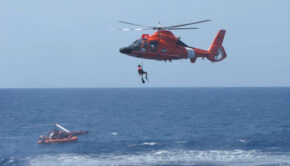Report Cites Problems with Spinlock Deckvests
Published on September 10th, 2013
By Darrell Nicholson, Practical Sailor
Within a day of US Sailing releasing a report that concluded that four out of five Spinlock Deckests failed to work properly in a fatal sailing accident earlier this year, PS testers were in the water with a Spinlock Deckvest (5D, 170N, Pro-Sensor inflator), trying to figure out what might have gone wrong.
The new Deckvest was among several racing PFDs we looked at in the July 2013 issue, and at that time, we found no significant problems with it. It and the Deckvest Lite earned Recommended ratings.
The report re-emphasizes what we’ve said several times before – inflate and try your PFD in the water as soon as you buy it. Make sure it keeps your head afloat without riding up around your head and neck. Learn how to service it, and adjust it for ideal fit. If it doesn’t fit, send it back and try another model.
I won’t go into the details of the accident involving the Columbia 32C Uncontrollable Urge here. The full report covers that well – and I urge you to read it as well as the 2012 US Sailing accident reports. I’ll focus only on inflatable bladder design detail that the investigators apparently blame for the vest’s failure. We have talked about this detail in the past, but in light of these findings, it bears repeating.
The main elements in the Spinlock Deckvest are the inflatable bladder and the neoprene harness/vest into which the bladder zips. On most inflatable PFD harnesses that we have tested, like those from Revere, Mustang, and West Marine, the bladder and the vest are integral components. The back of the bladder is sewn onto or thermo-welded to the vest. In some designs, however, like the Deckvest and the Bluestorm Xtreme, which we tested in August 2008, the bladders are joined to the vest at only three points – the top and the bottom of each side.
An additional strap on the right side of the Deckvest holds the bladder close to the vest, but on the left side, there is none (click to see photo). As a result, there can be a headsized gap between the vest and the bladder, if the vest is not cinched tightly around the wearer. If the inflatable PFD/harness does not have any crotch straps, the gap is even bigger, because the loose vest bunches up around the wearer’s neck and chest. – Read on








 We’ll keep your information safe.
We’ll keep your information safe.